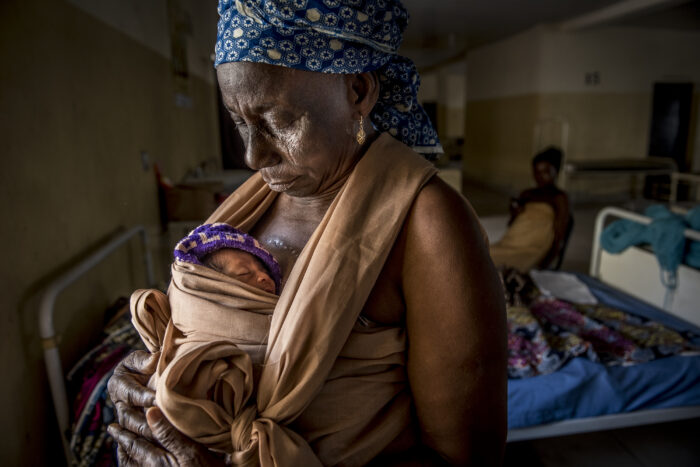Delivering Holistic, Quality Health Services for Mothers and Newborns
Two years ago, the warning signs of the impending COVID-19 pandemic were starting to appear on a global scale, putting years of progress in maternal and newborn health critically at risk. Recent data estimates have found that nearly 193,000 more children and 10,000 more women are dying each month in low- and middle-income countries (LMICs) due to COVID-19 disruptions than before the pandemic.1 The reality of these devastating numbers is that women and their newborns are in increased danger, and COVID-19 could have far-reaching consequences for child health and development for decades to come. As we enter into our third year of a world with COVID-19 – and continue to inch closer to meeting the SDG targets in 2030 – these new and complex challenges compel us to develop innovative ways to provide essential health services to pregnant mothers, newborns, and women across their lifecycle. To achieve this, we must bring the newborn and maternal health communities together – and truly capitalize on the power of moments like the upcoming AlignMNH Collective – to scale evidence-based practices and improve quality of care holistically.

The promising news is that we are starting to see this happen. At a high level, we are hearing and participating in conversations about putting women, pregnant mothers, and newborns at the center of strengthened health systems. This holistic approach to women’s health will not only better prepare us to weather future pandemics, it will also ensure we have services in place to address the unique and often interconnected needs of mothers and newborns, when and where they need them, at a price they can afford. Furthermore, we are seeing major signals from leaders in the field: With a vision toward the future, our two guiding global initiatives, Ending Preventable Maternal Mortality (EPMM) and the Every Newborn Action Plan (ENAP), have aligned on coverage targets and implementation milestones for the first time. The EPMM and ENAP communities, in collaboration with governments and other stakeholders, will continue to demonstrate their collective power to improve health systems for mothers and newborns as they prepare the first ever combined ENAP-EPMM progress report in 2023.

Beyond these promising shifts in the field, there are several tangible examples of interventions and innovations that have the potential to improve both maternal and newborn health – with the data to back it up. For instance, new research released in 2021 demonstrates that mothers offer some of the most beneficial “medicine” for their newborns through immediate Kangaroo Mother Care (KMC). One landmark study found that initiating KMC for preterm infants immediately after birth has the potential to save up to 150,000 more lives each year, when compared with starting KMC only when a small or sick newborn is stable.2 A second study found that amid the COVID-19 pandemic, the potential lives saved by KMC far exceeded the potential lives lost by possible COVID transmission from infected mother to newborn – as demonstrated by the finding that the benefit of KMC is 65-fold higher than the mortality risk of COVID-19.3 KMC represents huge promise in terms of improving health service delivery for mothers and newborns simultaneously – though, as with many impactful solutions, the road to implementation will require overcoming major physical, systemic, and cultural barriers. It’s exciting to be working alongside partners to continue to support this intervention as part of a larger integrated approach that prioritizes the spectrum of women’s health needs.
We also recognize that midwifery is one of the most effective best buys in providing a continuum of care for women, including drastically improving the care mothers and their newborns receive. Yet the reality is that midwives account for less than 10 percent of the global health workforce. They are still undervalued, under-utilized, and lack the resources they need to drive impact at scale. However, universal coverage of midwife-delivered interventions could allow 4.3 million lives to be saved annually by 2035.4 A full package of midwifery services, including family planning, can avert 83 percent of all maternal deaths, stillbirths, and newborn deaths.5 That’s why – following the 2018 Lancet Commission on High Quality Health Systems’ recommendation – we have been taking a deeper look at how to redesign health systems to provide the right services, such as midwifery, at the right level, by the right provider.6,7
Finally, we know that while maternal undernutrition does not receive adequate attention, it is the underlying risk factor of one in five maternal deaths and accounts for seven percent of the global disease burden.8 Maternal undernutrition also increases the risk of neonatal mortality, perinatal mortality, stillbirths, preterm births, neural tube defects, newborns with low birthweight, and those born small-for-gestational age. Given this data, we are working with our grantees and partners to incorporate maternal nutrition interventions for women into the health system before conception, during antenatal care, and after giving birth so they start and remain healthy and pass this strong foundation to their newborns – including supplements like iron and folic acid, IV iron, multiple micronutrient supplements (MMS), and balanced energy protein (BEP) to name a few.

Having spent decades working in women’s health, I’ve seen first-hand how critical these interventions are in addressing micronutrient deficiencies and ultimately, protecting the lives of mothers and newborns. For example, we know that anemia – a condition that affects nearly 30 percent of women of reproductive age – can put mothers at risk for a range of serious complications, including postpartum hemorrhage (PPH).9 PPH is one of the most dramatic and scary events to witness, and often leaves unskilled providers without hope of saving the mother’s life. What’s more, when a woman is hemorrhaging, the focus is on the mother and often providers are unable to perform the most crucial newborn interventions such as resuscitation or warming skin-to-skin care. These deadly situations can largely be avoided by addressing nutritional needs before a woman becomes pregnant and throughout pregnancy, with supplements and IV iron when diagnosed – effectively giving mothers the resilience and strength they need for a safe and healthy delivery.
As we begin to recover from the disruptions COVID-19 has caused, it is absolutely essential that we double down on prioritizing maternal and newborn health and strengthening health systems as a whole. To do this, we must support maternal health and newborn health communities to champion solutions together that truly meet the needs of women and their newborns. I look forward to participating in the AlignMNH Collective this April to further unpack this conversation and collectively develop solutions across the convening’s topic areas: respectful care, experience of care, and quality of care. This convening – which will mark 13 months until the International Maternal Newborn Health Conference (IMNHC) in Cape Town, South Africa – will provide an exciting opportunity to lead with evidence, share country knowledge, and take collective action to accelerate innovations for maternal and newborn health. Together, we can create the reality that healthy mothers can deliver healthy newborns, which in turn will strengthen communities, economies, and create more equitable futures for all.
Amy Pollack, MD, MPH is the Senior Director of Maternal, Newborn & Child Health, Family Planning, and Nutrition at the Bill & Melinda Gates Foundation.
Photography by Mubeen Siddiqui (first image) and Karen Kasmauski (second and third images) courtesy the Maternal and Child Survival Program.
1. The Lancet Global Health, “Early estimates of the indirect effects of the COVID-19 pandemic on maternal and child mortality in low-income and middle-income countries: a modelling study,” July 2020.
2. The New England Journal of Medicine, “Immediate “Kangaroo Mother Care” and Survival of Infants with Low Birth Weight,” May 27, 2021
3. The Lancet Discovery Science, “Preterm care during the COVID-19 pandemic: A comparative risk analysis of neonatal deaths averted by kangaroo mother care versus mortality due to SARS-CoV-2 infection,” March 2021
4. UNFPA, “The State of the World’s Midwifery 2021,” May 5, 2021.
5. Nove, A. et. al. Lancet. Vol 9, Issue 1, E24-32. January 2021.
6. Margaret E. Kruk et al., “Mortality Due to Low-Quality Health Systems in the Universal Health Coverage Era: A Systematic Analysis of Amenable Deaths in 137 Countries,” The Lancet 392, no. 10160 (2018).
7. S. Roder-DeWan et al., “Health System Redesign for Maternal and Newborn Survival: Rethinking Care Models to Close the Global Equity Gap,” BMJ Glob Health 5, no. 10 (2020).
8. The Lancet Maternal and Child Nutrition 2013. https://www.thelancet.com/series/maternal-and-child-nutrition.
9. WHO, “Anaemia in Women and Children: WHO Global Anaemia Estimates, 2021 Edition. https://www.who.int/data/gho/data/themes/topics/anaemia_in_women_and_children.

